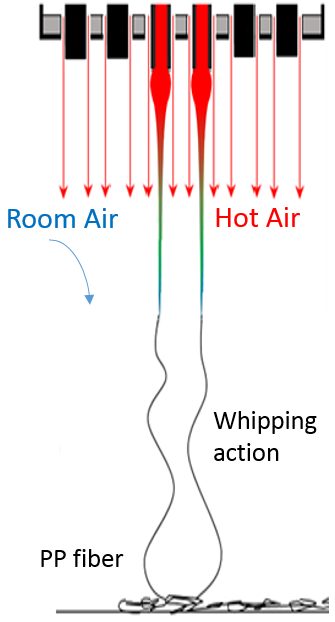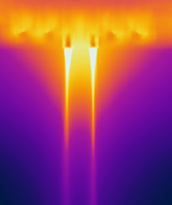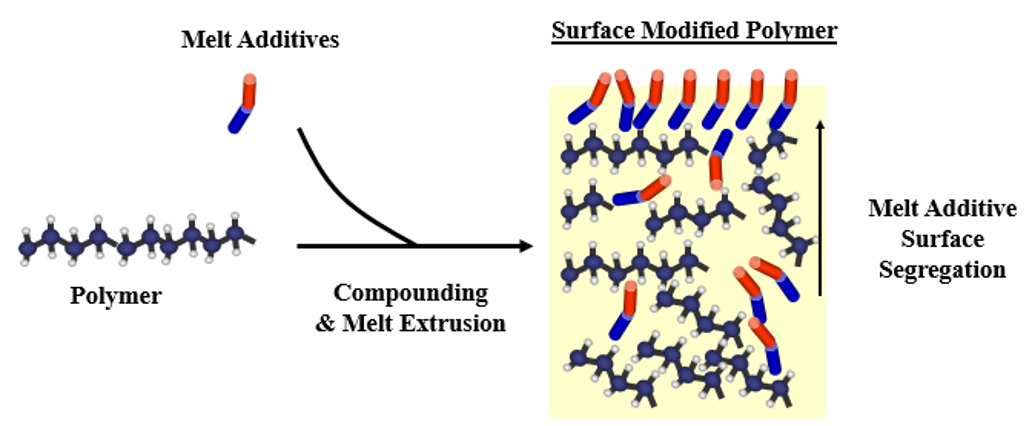Functional Fibers & Textiles
Development of High Surface Area Nonwovens
Researcher: Siyao Wang
Hybrid adsorptive nonwoven structures, where microporous carbon or metal-organic-framework (MOF) materials are added into a nonwoven fiber mesh are of strong interest for chemical capture, storage, delivery, catalysis, and other applications. Larger-scale pores are also made with porogen-based methods.
In this project, we plan to explore polymers of intrinsic microporosity (PIMs) as a new class of high surface area nonwovens (exceeding 500 m2/g), where the backbone of the starting spun-melt polymer provides intrinsic microporosity (i.e. pores < 2 nm) directly within the nonwoven fiber, without the need for porous additives. These PIM materials, are typically studied in powder or membrane form, with only recent demonstration of solution-extruded and electrospun fibers. Initial experiments will focus on fundamentals of polymer solution spinning (e.g., solution blowing) and electrospinning, with extension to opportunity for melt-processing.
Investigating the Biax Spunblown fiber formation process
Researcher: Stephen Barilovits
The Biax Spunblown® process is a unique variant of the meltblowing process. Molten polymer is extruded from an array of outlets each of which is individually surrounded by a concentric high velocity air stream. The Spunblown® process purportedly accommodates a wide range of polymer resins, produces fibers of similar size to meltblown, and uses reduced air volume as compared to traditional meltblowing. However, despite the aerodynamic differences from traditional meltblowing, the Spunblown® web formation process has been the study of little published research.


Infrared thermography has been used to determine fiber temperature during the spinning process and may be used to estimate fiber attenuation and determine appropriate die-to-collector distance. Results from IR image analysis indicate substantial heat transfer occurs between the air and molten polymer prior to spinning. Additionally, IR thermography demonstrates that larger fibers cool more slowly than more narrow fibers. A detailed three dimensional air temperature and velocity profile has been established for an array of supplied temperatures and air cavity pressures. Air heat dissipates more quickly than does air momentum, which is especially true very close to the spinnerets. The effect air temperature, polymer temperature, air speed, and polymer throughput have been related to fiber diameter distribution and distance to solidification. Fiber diameter distributions have been investigated as a function of an array of processing conditions and spinning stabilities. Decreases in polymer throughput most significantly reduced fiber diameters, but higher air temperature also lowered diameters substantially, and higher air pressures to a lesser extent. Spinning instability may significantly contribute to fiber size reduction through turbulent whipping action.
Zirconium Hydroxide Coatings for Protective Textiles
Researcher: Jenny Ovental
In recent years, zirconium hydroxide has become a material of interest for chemical warfare agent protection because of its reactivity towards a range of acid gases. Unfortunately, zirconium hydroxide is typically manufactured in powder form, which limits its applications. The goal of this project is to deposit zirconium hydroxide coatings on fiber surfaces to create protective textiles. To achieve this, we are exploring a range of deposition processes from gas-phase molecular layer deposition (MLD) to liquid phase layer-by-layer techniques, such as successive ionic layer adsorption and reaction.
Surface Energy Control with Polymer Melt Additives
Researcher: Joe Lavoie

The creation of superhydrophobic and superoleophobic surfaces is a technical challenge that is applicable to many different industries, including automotive, consumer electronics, adhesion and many others. In particular, oil repellent nonwoven materials have been designed for the protection of charged electret filters from loss of charge, however alcohol exposure of these products still pose a significant issue. Due to their extremely low surface tension compared to water and many oils, the creation of a surface which induces a significantly increased contact angle with alcohol is extremely challenging. This project explores the use of fluorochemical melt additives to generate nonwoven substrates with increased oil and alcohol repellency. These surfactant-like additive molecules are dispersed evenly throughout the fiber at the time of manufacturing, but due to their low surface energy, gradually segregate to the fiber surface over time. In this work, X-ray Photoelectron Spectroscopy (XPS) is being used to characterize the kinetics of the changing surface composition of the nonwoven fibers,throughout the migration process. This changing composition is then related to repellency via contact angle data. It has been shown that changing surface composition due to migration results in increased repellency. Samples with sufficient surface concentration of additive prevent wetting by isopropyl alcohol (IPA) and are therefore able to survive IPA vapor discharging tests in order to maintain filtration efficiency performance.
